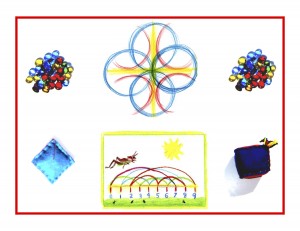Day 28
For one year, 365 days, this blog will address the Common Core Standards from the perspective of creating an alternate, ambient learning environment for math. Ambient is defined as “existing or present on all sides, an all-encompassing atmosphere.” And ambient music is defined as: “Quiet and relaxing with melodies that repeat many times.”
Why ambient? A math teaching style that’s whole and all encompassing, with themes that repeat many times through the years, is most likely to be effective and successful. Today’s blog will focus on the Kindergarten Common Core Math Standards and ambient counterparts that appeared in this blog on Days 17, 18 and 19. Note: standards may be paraphrased and will appear in blue.
Self-generated interest, especially at this age, is the most effective. There’s a wonderful willfulness that predominates in the child’s personality before the age of reason, that can be worked with to the advantage of everyone concerned! I always believed that a strong will in a child should be respected as a boon and a gift. Boundaries must be set and faithfully kept of course, but attempting to bend a child’s will to that of an adult can be frustratingly fruitless, so in that light, rely on the sweetness and allure of what you are doing to draw the child into any sphere of interest.
Day 17
Geometry K.G
Identify and describe shapes (squares, circles, triangles, rectangles, hexagons, cubes, cones, cylinders, and spheres).
2. Correctly name shapes regardless of their orientations or overall size. 3. Identify shapes as two-dimensional (lying in a plane, flat) or three-dimensional (solid).
Make the felt and paper hexagrams using the directions at the bottom of this post. No need for fanfare or announcements, just begin working at a table while the child(ren) play around you. Sing and finger-play the bee song while putting the gold felt hexagons together, then store them in a basket or bin in the Math Corner for free play. You may want to mix in some beeswax hexagons, and why not sculpt some beeswax bees? (Beeswax is the best modeling medium for young children.) Cutting the paper snowflakes should always be a guided activity. Introduce the varying sizes of the shapes and the comparison with the sandpaper shapes, then make these available in the Math Corner for free play as well. Start out one on one with the flat and solid shapes, but this activity could later be expanded to Circle Time.
Day 18
Geometry K.G
4. Analyze and compare two- and three-dimensional shapes, developing a familiarity with their differences and similarities, while using informal language to describe them.
Informal language can include the non-verbal, as shapes are experienced in a pure play mode: how different the bouncy sphere (exercise ball) feels from the sharp-cornered cardboard box, or the pointy cone! Guide little fingers and hands to feel the differences between the wooden and sandpaper shapes, then see this repeated often in the Math Corner. The large shapes activities are best set in Circle Time or Outside, look for them there. The cardboard tube cookie cutters however, are a perfect fit for the Free Play segment. This needs to be a more formal, guided activity rather than left for independent play. Do have fun with the large shapes during free play, both cardboard and fabric. I do encourage you to make the very large fabric shapes for boundless fun!
Day 19
Geometry K.G
5. Model and draw shapes, building them from components. 6. Compose simple shapes to form larger shapes.
Making the shapes with sticks for mobiles and constructing the god’s eyes are a good fit for free play time, but with guidance. The clay shapes and potato prints are a good fit for free play, again with guidance. See the play clay recipe at the bottom of the post. I just looked online and found real cookie cutter sets in shapes: circles, squares, and triangles!
Knowledge ensues in an environment dedicated to imaginative, creative knowing, where student and teacher alike surrender to the ensuing of that knowledge as a worthy goal. More Kindergarten tomorrow!












